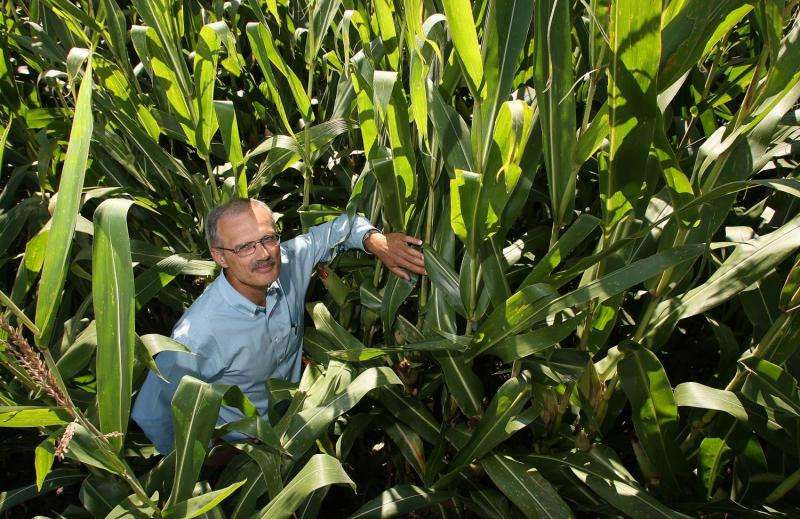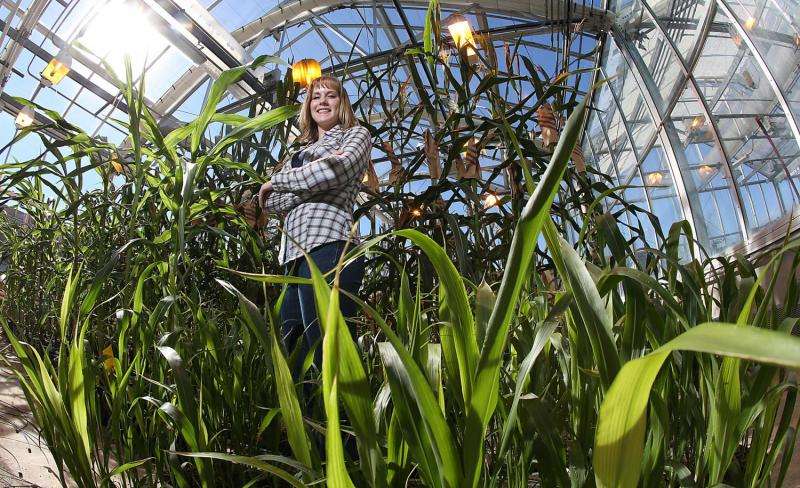Modern corn hybrids more resilient to nitrogen stress, crowded planting conditions

Modern corn hybrids produce more plant material and take up, on average, the same amount of nitrogen as earlier varieties, in spite of being more crowded and having less nitrogen available per plant, a Purdue University review finds.
In an analysis of 86 field experiments, agronomists found that corn hybrids released after 1990 prove more resilient than their predecessors in multiple ways. Modern hybrids maintain per-plant yield in environments with low nitrogen, can bounce back from mid-season stress and have an improved ability to take up nitrogen after silking, even if they suffered from nitrogen deficiency during flowering.
The study suggests reserving a portion of nitrogen fertilizer to apply later in the season could be a good bet for growers, said Tony Vyn, professor of agronomy.
"This is like insurance," he said. "Previously, withholding some of your nitrogen for later could be perceived as a risky venture - you don't want to inadvertently cause nitrogen deficiency. But this paper suggests that with modern hybrids, that risk is lower."
Nitrogen is an essential building block of plant proteins and plays a vital role in boosting grain yields. It's also notoriously mobile, said Sarah Mueller, doctoral student in agronomy and first author of the study.

"Once that nitrogen is in the soil, you start losing it," she said.
Growers want to keep the costly fertilizer in their fields and crops and prevent the loss of excess nitrogen to the atmosphere and water systems where it can cause environmental damage. But synchronizing nitrogen applications with plants' nitrogen uptake remains a challenge.
Mueller and Vyn's review offers valuable insights into how modern corn hybrids differ from pre-1990 varieties in their uptake of nitrogen and response to nitrogen deficiencies. Understanding these differences can help growers improve corn yields by maximizing nitrogen accumulation and applying nitrogen fertilizers more efficiently.
The study showed modern hybrids do more with less: They maintain grain yield on a per plant basis even when planted at higher densities than their predecessors - an average of 30,000 plants per acre compared with 20,000 - and despite average nitrogen fertilizer application rates remaining the same.
"These plants are able to maintain yield in the face of plant density stress and nitrogen stress," Mueller said. "That's pretty impressive and speaks to the overall resilience gains of modern hybrids."
The research also shows modern hybrids take up a substantial amount of new nitrogen as their grain develops. Modern corn hybrids take up about 36 percent of their total nitrogen after silking, compared with about 30 percent in older hybrids.
This late-season nitrogen uptake raises questions about whether splitting nitrogen fertilizer applications - rather than applying once early in the season - is a viable option for growers.
"These fundamental genetic changes could give us the opportunity for more flexibility in timing nitrogen applications," Vyn said. "We're researching this further because there could be gains in nitrogen fertilizer efficiency that could improve corn productivity and benefit the environment."
Vyn and Mueller cautioned that growers shouldn't shortchange their nitrogen applications, trusting modern hybrids to recuperate, but rather think about how reserving some nitrogen for later might prove advantageous in both optimum and adverse growing conditions.
Forty-three percent of the experiments analyzed were in the United States, and 32 percent were in China, with the remainder spread across the globe.
More information: Sarah M. Mueller et al. Maize Plant Resilience to N Stress and Post-silking N Capacity Changes over Time: A Review, Frontiers in Plant Science (2016). DOI: 10.3389/fpls.2016.00053
Provided by Purdue University















